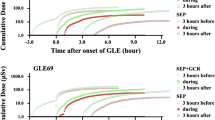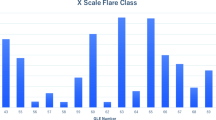Abstract
The purpose of this study is to compare and analyze the exposure dose of flight crew to space radiation. Flight selection was made from Gimpo Airport to domestic destinations of Jeju Island, Busan/Gimhae, Ulsan, Yeosu, Gwangju, and Daegu city. Dose measurements were based on the CARI-6/6M model developed by the Federal Aviation Administration and the Nowcast of Atmospheric Ionizing Radiation for Aviation Safety (NAIRAS) model, both developed by the Federal Aviation Administration. The results doses of 0.63 µSv at Jeju and 1.65 µSv at Busan/Gimhae based on the show NAIRAS model. The doses were 0.86 µSv (NAIRAS), 0.93 µSv, 1.03 µSv, 1.00 µSv fol destination of Yeosu, Ulsan, Gwangju, and Daegu, respective. Although there doses are light crews need to study appropriate safety management directions to protect themselves against space radiation, more over national standards and appropriate operational measures need to be established.
Similar content being viewed by others
References
M. Charles, J. Radiol. Prot. 21, 83 (2001).
K. J. Hwang, J. Jin Lee and K. S. Cho, J. Aviat. Dev. Korea 4, 73 (2010).
J. J. Lee et al., Korean Soc. Aeronaut. Space Sci. 1, 951 (2015).
Nuclear Safety and Security Commission. Act on protective action guidelines against radiation in the natural environment, Article 2, 2017.
S. H. Choi, J. Lee and H. J. Kim, Korean J. Air Space Law and Policy 31, 215 (2016).
Korea Foundation of Nuclear Safety, The flight crew should know the story of cosmic radiation, KoFONS/RE-015/2016.
Federal Aviation Administration report. Recent and Planned Developments in the CARI Program. Kyle Copeland, Civil Aerospace Medical Institute, Federal Aviation Administration, Oklahoma City, OK 73125. April 2013.
M. Garcia-Muňoz, G. M. Mason and J. A. Simpson, Astrophys. J. 202, 265 (1975).
B. J. Lewis et al., Radiat. Prot. Dosim. 86, 7 (1999).
D. G. Jang and S. H. Shin, J. Radiol. Sci. Technol. 41, 339 (2018).
Author information
Authors and Affiliations
Corresponding author
Rights and permissions
About this article
Cite this article
Cho, JH. Analysis of the Exposure of Domestic Flight Crews to Space Radiation. J. Korean Phys. Soc. 77, 197–200 (2020). https://doi.org/10.3938/jkps.77.197
Received:
Accepted:
Published:
Issue Date:
DOI: https://doi.org/10.3938/jkps.77.197




